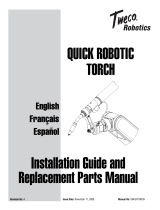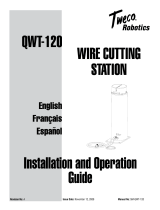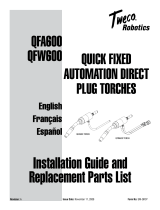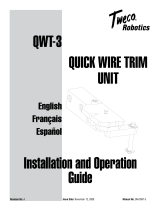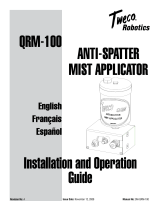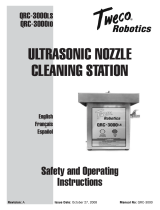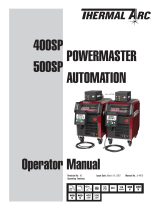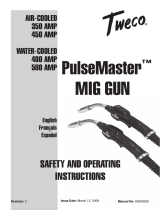La page est en cours de chargement...

50
60
Hz
1
PHASE
SMAW
GTAW
INVERTER
DC
CC
115
V
230
V
AUTOMATION
SERIES TORCHES
Installation Guide and
Replacement Parts Manual
English
Français
Español
QUICK FIXED
Art # JB-00005
Revision No: A Issue Date: November 17, 2008 Manual No: SM-QFTORCH

WE APPRECIATE YOUR BUSINESS!
Congratulations on your new Tweco® Robotics product. We are proud
to have you as our customer and will strive to provide you with the
best service and reliability in the industry. This product is backed
by our extensive warranty and world-wide service network. To locate
your nearest distributor or service agency call 800-426-1888, or visit
us on the web at www.tweco.com.
This Manual has been designed to instruct you on the correct
installation and use of your Tweco® Robotics product. Your
satisfaction with this product and its safe operation is our ultimate
concern. Therefore, please take the time to read the entire manual,
especially the Safety Precautions. They will help you to avoid potential
hazards that may exist when working with this product.
YOU ARE IN GOOD COMPANY!
The Brand of Choice for Contractors and Fabricators Worldwide.
Tweco® Robotics is a Global Brand of Arc Welding Products for
Thermadyne Industries Inc. We manufacture and supply to major
welding industry sectors worldwide including; Manufacturing,
Construction, Mining, Automotive, Aerospace, Engineering, Rural
and DIY/Hobbyist.
We distinguish ourselves from our competition through market-
leading, dependable products that have stood the test of time. We
pride ourselves on technical innovation, competitive prices, excellent
delivery, superior customer service and technical support, together
with excellence in sales and marketing expertise.
Above all, we are committed to develop technologically advanced
products to achieve a safer working environment within the welding
industry.

i
!
!
WARNING
Read and understand this entire Manual and your employer’s safety practices before installing, operating, or
servicing the equipment.
While the information contained in this manual represents the manufacturer’s best judgment,
the manufacturer assumes no liability for its use.
Quick Fixed Automation Robotics Torch
Installation Guide and Replacement Parts Manual
Instruction Manual Number SM-QFTORCH
Published by:
Tweco
®
Products Inc.
2800 Airport Road
Denton, TX 76208
(940) 566-2000
www.tweco.com
Copyright © 2008 by
Thermadyne Industries Inc.
®
All rights reserved.
Reproduction of this work, in whole or in part, without written permission of the publisher is prohibited.
The publisher does not assume and hereby disclaims any liability to any party for any loss or damage caused by any error or
omission in this Manual, whether such error results from negligence, accident, or any other cause.
Publication Date: November 17, 2008
Record the following information for Warranty purposes:
Where Purchased: ________________________
Purchase Date: ________________________
Equipment Serial #: ________________________
Registered Trademarks Miller
®
Lincoln
®
Panasonic
®
and Kevlar
®
are the respective property of their owners, not Thermadyne Industries, Inc.

ii
Quick fixed automation series torches
SM-QFTORCH
Table of Contents
SECTION 1: SAFETY INSTRUCTIONS AND WARNINGS .......................................... 1-1
1.01 Welding Hazards .......................................................................................1-1
1.02 Principal Safety Standards ........................................................................1-3
1.03 Safety and Health ......................................................................................1-3
SECTION 2: INTRODUCTION AND DESCRIPTION ................................................. 2-4
2.01 How to Use this Manual ............................................................................2-4
2.02 Receipt of Equipment ................................................................................2-4
2.03 Introduction ..............................................................................................
2-4
2.04 Standard features ......................................................................................2-4
2.05 Description ................................................................................................2-4
SECTION 3: INSTALLATION AND DISASSEMBLY ................................................. 3-6
3.01 Installation ................................................................................................3-6
3.02 Disassembly ..............................................................................................3-8
SECTION 4: WATER-COOLED TORCH BODY AND CABLE ASSEMBLY .......................... 4-9
SECTION 5: MAINTENANCE .........................................................................5-10
SECTION 6: TROUBLESHOOTING ..................................................................6-11
SECTION 7: REPLACEMENT PARTS ................................................................7-12
QFA Replacement Parts ...................................................................................7-12
QFW Series Replacement Parts .......................................................................7-15
SECTION 8: FIXED AUTOMATION CONDUITS LINERS ...........................................8-18
SECTION 9: FACTORY REPAIR CENTER ...........................................................9-19
LIMITED WARRANTY ................................................................................9-20

1-1
Quick fixed automation series torches
SM-QFTORCH
SAFETY INSTRUCTIONS AND WARNINGS
SECTION 1:
SAFETY INSTRUCTIONS AND WARNINGS
!
!
WARNING
SERIOUS INJURY OR DEATH may result if welding and cutting equipment is not properly installed, used and maintained.
Misuse of this equipment and other unsafe practices can be hazardous. The operator, supervisor, and helper must
read and understand the following safety warnings and instructions before installing or using any welding or cutting
equipment.
The welding and cutting process is used in many potentially dangerous environments such as elevated heights, areas
of limited ventilation, close quarters, around water, in hostile environments, etc., and it is important that the operator(s)
are aware of the dangers associated with working in these types of conditions. Be certain that the operator(s) are
trained in safe practices for environments in which they are expected to work and under competent supervision.
It is essential that the operator, supervisor and all other personnel in the work area are aware of the dangers of the
welding or cutting process. Training and proper supervision are important for a safe work place. Keep these instructions
for future use. Additional recommended safety and operating information is referenced in each section.
1.01 Welding Hazards
WARNING
electric shocK can cause injury or
death.
install and maintain equipment in
accordance With the national electrical
code (nfpa 70) and local codes. do not
service or repair equipment With poWer
on. do not operate equipment With
protective insulators or covers removed.
service or repair to equipment must be
done by a qualified repair technician, or
trained personnel only.
1.
Do not touch live electrical parts.
2.
Do not touch an electrode with bare skin and electrical
ground at the same time.
3. Always keep welding gloves dry and in good condition.
NOTE
Aluminized protective clothing can become part
of the electrical path.
4. Keep oxygen cylinders, chains, wire ropes, cranes, hoists,
and elevators away from any part of the electrical path.
5. All ground connections must be checked periodically
to determine that they are mechanically strong and
electrically adequate for the required current.
6. When engaged in alternating current, welding or cutting
under wet conditions or warm surroundings where
perspiration is a factor, the use of reliable automatic
controls for reducing the no-load voltage is recommended
to reduce shock hazard.
7. When the welding or cutting process requires values of
open circuit voltages in alternating current machines
higher than 80 volts, and direct current machines higher
than 100 volts, means must be provided to prevent the
operator from making accidental contact with the high
voltage by adequate insulation or other means.
8. When welding is to be suspended for any substantial
length of time, such as during lunch or overnight, all
electrodes should be removed from the electrode
holder and the electrode holder carefully located so that
accidental contact cannot occur.
9. The holder must be disconnected from the power source
when not in use.
10. Never immerse Mig-Guns, electrode holders, tig torches,
plasma torches, or electrodes in water.
WARNING
smoKe, fumes and gases can be dangerous
to your health.
11. Keep smoke, fumes, and gases from the breathing
area.
12. Fumes from the welding or cutting process are of various
types and strengths, depending on the kind of base metal
being worked on. To ensure your safety, do not breathe
these fumes.
13. Ventilation must be adequate to remove smoke, fumes,
and gases during the operation to protect operators and
other personnel in the area.

1-2
Quick fixed automation series torches
SM-QFTORCH
SAFETY INSTRUCTIONS AND WARNINGS
14. Vapors of chlorinated solvents can form the toxic gas
“Phosgene” when exposed to ultraviolet radiation from
an electric arc. All solvents, degreasers and potential
sources of these vapors must be removed from the work
area.
15. Fumes produced by welding or cutting, particularly in
confined places, can cause discomfort and physical harm
if inhaled over an extended period of time.
16. Provide adequate ventilation in the welding or cutting
area. Use air-supplied respirators if ventilation is not
adequate to remove all fumes and gases. Never ventilate
with oxygen. Oxygen supports and vigorously accelerates
fire.
WARNING
arc rays, hot slag, and sparKs can injure
eyes and burn sKin .
17. The welding and cutting processes produce extreme
localized heat and strong ultraviolet rays.
18. Never attempt to weld or cut without a welding helmet
with the proper lens. Ensure that the lens complies with
federal guidelines. A number 12 to 14 shade filter lens
provides the best protection against arc radiation. When
in a confined area, prevent the reflected arc rays from
entering around the helmet.
19. Ensure all personnel in the work area are protected from
arc rays and sparks. Approved shielding curtains and
appropriate goggles should be used to provide protection
to staff in the surrounding area and operators of nearby
equipment.
20. Unprotected skin should also be covered from arc rays,
heat and molten metal. Always wear protective gloves
and clothing that does not allow skin to become exposed.
All pockets should be closed and cuffs sewn shut. Leather
aprons, sleeves, leggings, etc., should be worn for out-of-
position welding and cutting or for heavy operations using
large electrodes. High top work shoes provide adequate
protection from foot burns. For added protection use
leather spats.
21. Flammable hair preparations should not be used when
welding or cutting. Wear ear plugs to protect ears from
sparks.
22. Where the work area permits, the operator should be
enclosed in an individual booth painted with a finish of
low reflectivity such as zinc oxide. This is an important
factor for absorbing ultraviolet radiations, and lamp black.
The operator should be enclosed with non-combustible
screens similarly painted.
WARNING
Welding sparKs can cause fires and
eXplosions.
23. Causes of fire and explosion are: combustibles reached by
the arc, flame, flying sparks, hot slag or heated material.
Remove combustibles from the work area and/or provide
a fire watch.
24. Avoid oily or greasy clothing as sparks may ignite them.
Have a fire extinguisher nearby, and know how to use
it.
25. Be alert to the danger of conduction or radiation. For
example, if welding or cutting is to be done on a metal
wall, partition, ceiling, or roof, precautions must be taken
to prevent ignition of combustibles on the other side.
26. Do not weld or cut containers that have held combustibles.
All hollow spaces, cavities, and containers should be
vented prior to welding or cutting to permit the escape
of air or gases. Purging with inert gas is recommended.
27. Never use oxygen in a welding torch. Use only inert gases
or inert gas mixes as required by the process. Use of
combustible compressed gases can cause explosions
resulting in personal injury or death. Arcing against any
compressed gas cylinder can cause cylinder damage or
explosion.
WARNING
noise can damage hearing.
28. Noise from the air carbon-arc process can damage
your hearing. Wear protective hearing devices to ensure
protection when noise levels exceed OSHA standards.
Adequate hearing protection devices must be worn by
operators and surrounding personnel to ensure personal
protection against noise.

1-3
Quick fixed automation series torches
SM-QFTORCH
SAFETY INSTRUCTIONS AND WARNINGS
1.02 Principal Safety Standards
1.03 Safety and Health
NOTE
Be sure to read and fully comprehend the safety
instuctions and warnings contained within section
1 of this manual before performing any welding
or cutting operations.
!
!
WARNING
serious injury or death may result if
Welding and cutting equipment is not
properly installed, used and maintained.
misuse of this equipment, or other unsafe
practices, can be hazardous.
Electric shock can cause injury or death.
Smoke, fumes, and gases can be dangerous to your
health.
Arc rays, hot slag, and sparks can injure or burn
unprotected eyes and skin.
Welding sparks can cause fires and explosions.
Excessive noise can damage your hearing.
•
•
•
•
•
SAFETY AND OPERATING REFERENCES
1. Code of Federal Regulations. (OSHA)
Section 29 Part 1910.95, 132, 133, 134, 139, 251, 252, 253, 254 and 1000.
U.S. Government Printing Office, Washington, DC. 20402.
2. ANSl Z49.1 "Safety In Welding and Cutting."
3. ANSI Z87.1 "Practice for Occupational and Educational Eye and Face Protection."
4. ANSl Z88.2 "Standard Practice for Respiratory Protection."
American National Standards Institute, 1430 Broadway, New York, NY. 10018.
5. AWS F4.1 "Recommended Safe Practices for Welding and Cutting Containers."
6. AWS C5.3 "Recommended Practices for Air Carbon-Arc Gouging and Cutting."
The American Welding Society, 550 NW Lejeune RD., P.O.Box 351040, Miami FL. 33135
7. NFPA 51B “Fire Prevention in Cutting and Welding Processes.”
8. NFPA-7 “National Electrical Code.”
National Fire Protection Association, Battery Park, Quincy, MA. 02269.
9. CSA W117.2, "Safety in Welding, Cutting and Allied Processes."
Canadian Standards Association, 178 Rexdale Blvd., Rexdale, Ontario, Canada M9W 1R3.
!
!
WARNING
this product contains chemicals,
including lead, or otherWise produces
chemicals KnoWn to the state of
california to cause cancer, birth
defects and other reproductive harm.
Wa s h h a n d s a f t e r h a n d l i n g.
(california health & safety code § 25249.5
et seq.)

2-4
Quick fixed automation series torches
SM-QFTORCH
INTRODUCTION AND DESCRIPTION
SECTION 2:
INTRODUCTION AND DESCRIPTION
2.01 How to Use this Manual
To ensure safe operation, read the entire manual, including
the chapters on safety instructions and warnings.
Throughout this manual, the words
WARNING, CAUTION, and
NOTE may appear. Pay particular attention to the information
provided under these headings. These special annotations
are easily recognized as follows:
!
!
WARNING
a Warning gives information regarding
possible personal injury.
CAUTION
A CAUTION refers to possible equipment
damage.
NOTE
A NOTE offers helpful information concerning
certain operating procedures.
2.02 Receipt of Equipment
When you receive the equipment, check it against the invoice
to make sure it is complete and inspect the equipment for
possible damage due to shipping. If there is any damage,
notify the carrier immediately to file a claim. Furnish complete
information concerning damage claims or shipping errors to
the location in your area listed in the inside back cover of this
manual. Include a full description of the parts in error.
If you want additional or replacement copies of this CD,
please contact Tweco
®
Robotics at the address and phone
number in your area listed on the inside back cover of this
manual. Include the Manual number (from page i) and CD
part number: 64-2601.
2.03 Introduction
The Tweco
®
Robotics Quick Fixed Automation Torch series
are offered in either air-cooled or water/air-cooled cable
assemblies. Both series of the Quick Fixed Automation Torches
are offered in lengths 4ft. (91cm) – 15ft. (5m).
2.04 Standard features
Quick conductor tube lock for easy conductor tube
replacement.
Inner cable protective jacket.
Heavy cable support springs on both front and rear.
Kevlar
®
/Nylon outer protective cable cover.
Water-cooled cables have built in water shut-off valves
in the front housing.
Quick hose connections on all water-cooled cables.
Internal purge hose for spraying anti-spatter through
the conductor tube and nozzle.
All cable assemblies are furnished with a Tweco
®
,
Miller
®
, and Lincoln
®
rear connector plug.
2.05 Description
QF Series Air-cooled Torch Body and Cable Assembly
The air-cooled QFA cable assembly uses QTR66 air-cooled
conductor tubes. It has an air-cooled power cable rated at
600 amperes @ 60% duty cycle.
•
•
•
•
•
•
•
•

2-5
Quick fixed automation series torches
SM-QFTORCH
INTRODUCTION AND DESCRIPTION
A
rt # JB-00006
Figure 2-1: QF Series (Air-cooled)
QF Series Water/ Air-cooled Torch Body and Cable Assembly
The QFW cable assembly is a hybrid using QTRW63, QTRW64, or QTRW66 water-cooled conductor tubes but it utilizes an
air-cooled power cable assembly rated up to 600 amperes @ 80% duty cycle. If water flow is interrupted, amperage rating
is decreased. This provides a torch that has water-cooling of the front consumables while providing a trouble free rugged
air-cooled cable assembly.
Art # JB-00007
Figure 2-2: QF Series (Water/Air-cooled)
A wide variety of conductor tube and front-end consumables are also offered. Contact your local welding distributor and or
Tweco
®
Customer Care Department (1-800-426-1888) for assistance in choosing the correct conductor tube and consumables
for your welding application.

3-6
Quick fixed automation series torches
SM-QFTORCH
INSTALLATION AND DISASSEMBLY
SECTION 3:
INSTALLATION AND DISASSEMBLY
3.01 Installation
1. Remove the torch and cable assembly from the carton,
and lay the assembly in a straight and untwisted position
on a workbench or floor.
2. Check to ensure all items shown in Figure 2-1 & 2-2
on Page 2-5 are located and identified. If any of the
component parts are missing, please notify the local
Tweco
®
Welding Distributor or Tweco
®
Products Customer
Care Department at 1-800-426-1888.
3. Verify that the overall cable length is correct to fit between
the feeder - torch mount combination.
4. The QF series torch and cable assemblies are furnished
with a 1-5/8” (41,28mm) Ø mounting diameter and can
be keyed in place into a fixture if so desired.
5. Rotate the front sleeve cover to expose the stainless steel
set screw located in the torch block assembly. Insert the
factory supplied 5/32” T-handle allen wrench into the set
screw and rotate counterclockwise until it stops as shown
in Figure 3-1.
ROTATE FRONT SLEEVE COVER
TO EXPOSE SET SCREW, ROTATE
COVER TO CONCEAL SET SCREW
PRIOR TO TORCH OPERATION.
SET SCREW
(5/32" ALLEN KEY
Art # JB-00008
Figure 3-1: Conductor Tube Locking Set Screw
6. Insert the conductor tube assembly into the torch block
assembly. The conductor tube is positively located into
the torch body by the use of two stainless steel alignment
pins.
7. Push the conductor tube assembly into place until the
stainless steel set screw can drive the back plug on the
conductor tube into its locked operating position. The
conductor tube has a machined locating groove around
its rear diameter. This groove will be flush with the front
housing when properly installed as shown in Figure 3-
2.
WHEN CONDUCTOR TUBE IS FULLY SEATED,
GROOVE ON TUBE SHOULD LINE UP WITH
EDGE OF INSULATING SLEEVE.
Art # JB-00009
Figure 3-2: Conductor Tube Installation
8. Remove the gas diffuser, tip, and nozzle from the
conductor tube assembly.
9. The torch and cable assembly comes with the Miller
®
rear
connector plug installed. If the feeder requires a different
rear connector plug, select the correct rear connector
plug for the feeder being used and thread the plug into
the rear of cable assembly. This connection should be
wrench tight.
10. The QF Series torch and cable assemblies are furnished
with R45-116 conduit and the rear connector plugs to
fit this series of conduit. If a different conduit and rear
connector plug is required, refer to Page 8-18 listing the
various conduits that are available.
11. Remove the conduit from the package and uncoil carefully.
CAUTION
Bending or distorting the conduit can cause wire
feed problems.
12. Loosen the set screw located on the Tweco, Panasonic
®
and Lincoln
®
rear connector plug to ensure the conduit will
feed through properly. For Miller
®
style plug, remove the
threaded connector plug nipple from the rear connector
plug on the torch assembly. Refer to Figure 3-3 & 3-4.
SET SCREW
TWECO PLUG
CONDUIT ASSEMBLY
A
rt # JB-00010
Figure 3-3: Conduit Installation with Set Screw
MILLER PLUG
CONDUIT ASSEMBLY
PLUG NIPPLE
A
rt # JB-00011
Figure 3-4: Conduit Installation with Plug Nipple (Miller
®
style)
13. Insert the factory-supplied 5/32” T-handle Allen wrench
through the hole on the aluminum front handle cap,
identified as “Conduit Set Screw” on the label, and rotate
the set screw counterclockwise until it stops rotating.
14. Insert the exposed raw coil end of the conduit, factory
supplied, into the rear connector plug. Feed the conduit
through the gun and conductor tube assembly. If the
conduit attempts to hang up, rotate the conduit liner
counterclockwise while gently pushing.
15. When the conduit is completely through the torch and
conductor tube assembly, seat the brass conduit stop
firmly against the connector plug.

3-7
Quick fixed automation series torches
SM-QFTORCH
INSTALLATION AND DISASSEMBLY
16. Tighten the set screw on the Tweco
®
, Panasonic
®
, and
or Lincoln
®
rear connector plug. For Miller
®
style rear
connector plug, re-install the threaded connector plug
nipple. This connection should be wrench tight.
17. Re-insert the factory-supplied 5/32” T-handle allen
wrench into the hole for the “Conduit Set Screw” on the
front handle cap and rotate the set screw clockwise. The
set screw should be hand tight. Refer to Figure 3-5.
CONDUIT SET SCREW HOLE
A
rt # JB-00012
Figure 3-5: Access hole for Conduit Set Screw
18. Trim the conduit extending from the front of the conductor
tube assembly by following the steps below:
Method “A” – Using a tape measure or scale, mark and
cut the conduit to the cut length noted in the
table below. Refer to Figure 3-6 — Method
“A”.
Method “B” – The diffusers have a machined groove
around the outer diameter. Position the
diffuser as shown in Figure 3-6 — Method
“B” and mark and cut the conduit.
Conductor Tube Assemby Cut Length “A”
QTR66 Series – (For use with QRA series torch/cable assemblies)
1-5/16” (33,32mm)
QTRW63 Series – (For use with QRW & QRWA series torch/cable assemblies)
15/16” (23,80mm)
QTRW64 Series – (For use with QRW & QRWA series torch/cable assemblies)
¼” (6,35mm)
QTRW66 Series – (For use with QRW & QRWA series torch/cable assemblies)
5/16” (7,92mm)
Table 3-1: Conductor Tube Cut Lengths
CUT LINE
A
”B“ DOHTEM”A“ DOHTEM
Art # JB-00013
19. After trimming to length, remove any obstructions from the end of the conduit radius.
20. Re-install the diffuser, tip, and nozzle onto the conductor tube assembly.
21. Loosen the fixture connection and insert the cartridge kit of the torch and conductor tube assembly into position. The
keystock located on the cartridge kit should be placed into the mating slot on the fixture until the sleeve bottoms against
the fixture plate. Re-tighten the connection to secure the assembly in place. Refer to Figure 3-7.
KEYSTOCK
A
rt # JB-00014
Figure 3-7: Locating Keystock
NOTE
For cable assemblies longer than 5ft. (1,52m), it
is recommended incorporating a spring-loaded
stabilizer bar/balancer to the robot work cell to
provide support to the center of the cable assembly.
This will eliminate both excessive drooping of the
cable assembly and any interference with the
fixtures and tooling in the work area.
22. Install the rear connector plug into the feeder.
23. If the torch being installed is a water-cooled QFW series,
a water supply providing not less than ¾ gallons/minute
(2.84 liters/minute) water flow, must be used during
operation. The water supply should be installed to run
when the power source is turned “on” if possible to avoid
any damage to the torch and cable assembly.
Figure 3-6: Conduit Cut Length

3-8
Quick fixed automation series torches
SM-QFTORCH
INSTALLATION AND DISASSEMBLY
CAUTION
Operating a water-cooled torch and cable
assembly without water or restricted flow will
result in damage to the cable assembly.
24. The torch and cable assembly is furnished with a purge
hose than can be used to supply inert gas and or anti-
spatter through the torch block and conductor tube
assembly. To use this purge hose, remove the plastic
plug and connect accordingly.
25. The torch is now ready to place into operation.
3.02 Disassembly
1. To disassemble the torch and cable assembly from the
fixture, reverse the steps noted in Section 3.01.

4-9
Quick fixed automation series torches
SM-QFTORCH
WATER -COOLED TORCH BODY & CABLE ASSEMBLY
SECTION 4:
WATER-COOLED TORCH BODY AND CABLE ASSEMBLY
The water-cooled torch and cable assemblies incorporate water shut-off valves allowing the conductor tube to be removed
without shutting off the water supply. This reduces the chance of introducing moisture into the conductor tube and conduit.
Refer to Figure 4-1 showing the water shut-off valves on the QFW Series Torch Body and Cable Assembly.
VALVE
SPRING
HOSE NIPPLE
Art # JB-00015
Figure 4-1: QFW Series Check Valves
A water supply providing not less than ¾ gallons/minute (2.84 liters/minute) water flow must be used during operation. The
water supply should be installed to run when the power source is turned “on” if possible to avoid any damage to the torch
and cable assembly.
CAUTION
Operating a water-cooled torch and cable
assembly without water or restricted flow will
result in damage to the cable assembly.
If the threaded power connection is removed from the QRW series block assembly make sure the component parts making up the
check valve remains inside of the block assembly. If the components are removed, make sure they are installed properly.

5-10
Quick fixed automation series torches
SM-QFTORCH
MAINTENANCE
Each Use
Visual check of torch
Consumable parts
Weekly
Visually inspect the torch
body and consumables
Visually inspect the
cables and leads.
Replace as needed
3 Months
Clean
exterior
of power supply
6 Months
Replace all
broken parts
Visually check and
use a vacuum to carefully
clean the interior
Gas and
air lines
dwg-00032
Visually inspect the Wire
feed mechanisms
Warning!
Disconnect input power before maintaining.
Maintain more often
if used under severe
conditions.
Visual check of
regulator and pressure
SECTION 5:
MAINTENANCE
Contact tips and nozzles should be cleaned frequently. Spatter
buildup may cause bridging between nozzle and tip. This
could cause electrical shorting between the nozzle and work
piece as well as restricting gas flow.
Regularly inspect the conductor tube, torch and cable
assembly for abrasions, cuts, and undue wear. Replace or
repair any parts as needed.
The torch and conductor tube assemblies have o-rings for
seals. Lubrication of these o-rings should be done periodically
and periodical inspections should be made to ensure that the
o-rings do not de-grade, allowing water and/or shielding gas
leaks to occur. When removing the conductor tube from the
torch assembly, be sure the single o-ring located in the bottom
of the hole remains in place.

6-11
Quick fixed automation series torches
SM-QFTORCH
TROUBLESHOOTING
SECTION 6:
TROUBLESHOOTING
Problem Possible Cause Corrective Action
Wire feed inconsistent or not
smooth.
1. Loose drive rollers on feeder.
2. Dirty or plugged conduit
3. Conduit pulled back from diffuser.
4. Sharp bends or kinks in conduit.
5. Machine improperly adjusted.
6. Spatter buildup on end of contact
tip.
7. Loose contact tip or diffuser.
8. Excessively worn contact tip.
9. Loose ground cable or ground
clamp.
1. Tighten drive rollers.
2. Replace conduit.
3. Reposition conduit and tighten front
screw.
4. Remove and replace conduit.
5. Reset machine per machine and wire
manufacturers’ recommendations.
6. Clean or replace contact tip.
7. Tighten contact tip and diffuser plier
tight.
8. Replace contact tip.
9. Tighten or replace as required.
Torch and cable assembly is running hot. 1. L o o s e p o w e r c o n n e c t i o n .
2. Loose or undersize ground cable or
ground clamp.
3. Conductor tube not tight in torch
block.
4. Loose contact tip or diffuser.
5. Operating torch and cable assembly
above recommended amperage
rating.
6. Power cable assembly damaged.
7. Restricted water flow (only QFW
series torch).
1. Inspect complete torch and cable for
loose connections and tighten.
2. Tighten or replace as required.
3. Tighten stainless setscrew in torch
block.
4. Tighten contact tip and diffuser.
5. Readjust machine to correct
setting for size of torch being used.
6. Inspect and replace accordingly.
7. Inspect water lines for any excessive
bends.
Porous weld 1. Poor or improper gas flow.
2. Moisture from torch/conductor tube.
1. Dirty or contaminated wire.
2. Base metal contamination.
1. Check gas flow out of conductor tube
nozzle. Check for leaks or restrictions
in gas hoses and connections.
2. Check O-rings on conductor tube and
torch block. Check the torch block for
any scarring, gouges to the surface.
1. Change wire.
2. Replace base metal.

7-12
Quick fixed automation series torches
SM-QFTORCH
REPLACEMENT PARTS
SECTION 7:
REPLACEMENT PARTS
QFA Replacement Parts
1
4
8
11
9
15
17
16
18
13
14
19
3
2
5
6 7 10 12
A
A
rt # JB-00016

7-13
Quick fixed automation series torches
SM-QFTORCH
REPLACEMENT PARTS
QFA Series Replacement Parts
Item No. Part No. Stock No. Description
1 --- --- Cartridge Kit - (Includes Item #2, #3, and Hose Clamps)
QRA-1BC 3045-1150 For use with 1-5/8” (41,28mm) Ø Mount – QRA Series - ***
NS QR106RLS 3045-1341 Replacement Locking Set Screw F/Torch Block (Pkg. of 5 ea.)
2 --- --- Key
QTRMS-BS 3045-1156 For use with QRA-1BC Cartridge Kit (Pkg. of 5 ea.)
3 QR106-S 3045-1158 Conduit Screw (Pkg. of 5 ea.)
4 QR-FC 3045-1161 Front Case (Includes Item “B”)
5 --- --- QFA Power Cable Assy (Includes Hose Clamps)
QR604-CH 3045-1166 For use with 4ft. ( 1,22m) torch
QR606-CH 3045-1170 For use with 6ft. (1,83m) torch
QR608-CH 3045-1172 For use with 8ft. (2,44m) torch
QR610-CH 3045-1173 For use with 10ft. (3m) torch
QR612-CH 3045-1174 For use with 12ft. (4m) torch
QR615-CH 3045-1175 For use with 15ft. (5m) torch
6 --- --- Front Spring
QR-SPR 3045-1177 For use with 4ft. (1,22m) through 7ft. (2,13m) torches
QR-SPHD 3045-1178 For use with 8ft. (2,44m) through 15ft. (5m) torches
7 --- --- Rear Spring
QTR-SP 3045-1176 For use with 3ft. (91cm) & 3.5ft. (1,07m) torches
QR-SPHD 3045-1178 For use with 4ft. (1,22m) through 15ft. (5m) torches
8 --- --- Purge Hose Assembly (Includes Hose Plug Nipple & Clamp)
QR04-PH 3045-1202 For use with 4ft. ( 1,22m) torch
QR06-PH 3045-1206 For use with 6ft. (1,83m) torch
QR08-PH 3045-1208 For use with 8ft. (2,44m) torch
QR10-PH 3045-1209 For use with 10ft. (3m) torch
QR12-PH 3045-1210 For use with 12ft. (4m) torch
QR15-PH 3045-1211 For use with 15ft. (5m) torch
9 --- --- Kevlar
®
/Nylon Cover Assembly (Includes Cable Tie – 2 each)
QR04-LC 3045-1228 For use with 4ft. ( 1,22m) torch
QR06-LC 3045-1232 For use with 6ft. (1,83m) torch
QR08-LC 3045-1234 For use with 8ft. (2,44m) torch
QR10-LC 3045-1235 For use with 10ft. (3m) torch
QR12-LC 3045-1236 For use with 12ft. (4m) torch
QR15-LC 3045-1237 For use with 15ft. (5m) torch
10 QR-RC 3045-1238 Rear Spring Cap
11 QRA-CS 3045-1239 Rear Case Assembly
12 R176MH 2060-2184 Miller
®
Connector Plug (Includes Items #16 & 17) - ***
R174MH 2035-2109 Miller
®
Connector Plug (Includes Items #16 & #17)
13 R175M-N045 2050-2181 Miller
®
Plug Nipple, .045” (1,0mm) Wire (Use w/R176MH) - ***
R174M-N045 2040-2192 Miller
®
Plug Nipple, .045” (1,0mm) Wire (Use w/R174MH)
14 R175M-N116 2050-2182 Miller
®
Plug Nipple, .062” (1,6mm) Wire (Use w/R176MH) - ***
R174M-N116 2040-2191 Miller
®
Plug Nipple, .062” (1,6mm) Wire (Use w/R174MH)
*** Standard on all QFA Series Torch Body and Cable Assemblies

7-14
Quick fixed automation series torches
SM-QFTORCH
REPLACEMENT PARTS
Item No. Part No. Stock No. Description
15 176S-H 2060-2177 Tweco
®
Connector Plug - ***
350-174H 2035-2110 Tweco
®
Connector Plug (Uses R44 series Conduit)
16 350-174PH 2035-2172 Panasonic
®
Connector Plug (Uses R44 series Conduit )
17 QTR176LH 2086-2624 Lincoln
®
Connector Plug (2.71” – 68,83mm OAL.) - ***
EL176LH 2060-2680 Lincoln
®
Connector Plug (3.84” – 97,54mm OAL)
QTR174LH 2086-2623 Lincoln
®
Connector Plug (Uses R44 series Conduit)
18 --- --- Conduit (Refer to Page 18)
19 QTR-TOOLS 2062-2034 Tool Kit
Standard Fasteners
These standard fasteners are not sellable items and must be purchased at a local hardware or fastener supply house.
Item No. Description
A #10-32 x 3/16” Stainless Cup Point Set Screw
QFA Series Replacement Parts (cont.)
*** Standard on all QFA Series Torch Body and Cable Assemblies

7-15
Quick fixed automation series torches
SM-QFTORCH
REPLACEMENT PARTS
QFW Series Replacement Parts
10
1
4
9
12
14
5
2
3
6
7 8 13 15
A
11
23
18
20
19
21
16
17
22
Art # JB-00017

7-16
Quick fixed automation series torches
SM-QFTORCH
REPLACEMENT PARTS
QFW Series Replacement Parts
Item No. Part No. Stock No. Description
1 --- --- Cartridge Kit - (Includes Item #2, #3 and Hose Clamps)
QRWA-1BC 3045-1288 For use with 1-5/8” (41,28mm) Ø Mount – QRWA Series - ***
NS QR106RLS 3045-1341 Replacement Locking Set Screw F/Torch Block (Pkg. of 5 ea.)
2 --- --- Key
QTRMS-BS 3045-1156 For use with QRA-1BC (Pkg. Of 5 ea.)
3 QR106-S 3045-1158 Conduit Screw (Pkg. Of 5 ea.)
4 QR-FC 3045-1161 Front case (Includes Item “B”)
5 QRW-CV 3045-1304 Check Valve Assembly (Includes O-rings)
6 --- --- QFW Power Cable Assy (Includes Hose Clamp)
QR404-CH 3045-1252 For use with 4ft. ( 1,22m) torch
QR406-CH 3045-1256 For use with 6ft. (1,83m) torch
QR408-CH 3045-1258 For use with 8ft. (2,44m) torch
QR410-CH 3045-1259 For use with 10ft. (3m) torch
QR412-CH 3045-1260 For use with 12ft. (4m) torch
QR415-CH 3045-1261 For use with 15ft. (5m) torch
7 --- --- Front Spring
QR-SPR 3045-1177 For use with 4ft. (1,22m) through 7ft. (2.13m) torches
QR-SPHD 3045-1178 For use with 8ft. (2,44m) through 15ft. (5m) torches
8 --- --- Rear Spring
QR-SPHD 3045-1178 For use with 4ft. (1,22m) through 15ft. (5m) torches
9 --- --- Purge Hose Assembly (Includes Hose Nipple Plug & Hose Clamp)
QR04-PH 3045-1202 For use with 4ft. ( 1,22m) torch
QR06-PH 3045-1206 For use with 6ft. (1,83m) torch
QR08-PH 3045-1208 For use with 8ft. (2,44m) torch
QR10-PH 3045-1209 For use with 10ft. (3m) torch
QR12-PH 3045-1210 For use with 12ft. (4m) torch
QR15-PH 3045-1211 For use with 15ft. (5m) torch
10 --- --- Water-Out Hose Assembly (Includes Hose Clamp)
QRW04-WO 3045-1265 For use with 4ft. ( 1,22m) torch
QRW06-WO 3045-1269 For use with 6ft. (1,83m) torch
QRW08-WO 3045-1271 For use with 8ft. (2,44m) torch
QRW10-WO 3045-1272 For use with 10ft. (3m) torch
QRW12-WO 3045-1273 For use with 12ft. (4m) torch
QRW15-WO 3045-1274 For use with 15ft. (5m) torch
11 --- --- Water-In Hose Assembly (Includes Hose Clamps)
QRW04-WI 3045-1277 For use with 4ft. ( 1,22m) torch
QRW06-WI 3045-1281 For use with 6ft. (1,83m) torch
QRW08-WI 3045-1283 For use with 8ft. (2,44m) torch
QRW10-WI 3045-1284 For use with 10ft. (3m) torch
QRW12-WI 3045-1285 For use with 12ft. (4m) torch
QRW15-WI 3045-1286 For use with 15ft. (5m) torch
*** Standard on all QFW Series Torch Body and Cable Assemblies
/

